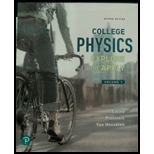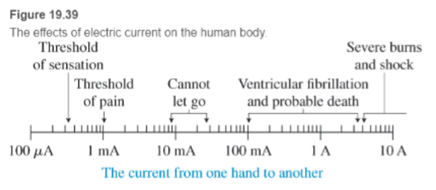
BIO Effect of
A potential difference across two parts of the body (for example, the 120-V potential difference from a wall socket from one hand to the other or from the hands to the feet) can initiate an electric current in the body that stimulates nerve endings and triggers nerve signals that cause muscular contraction. Even worse, the current in the body can upset the rhythmic electrical operation of the heart. The heart muscles might be stimulated randomly in what is called ventricular fibrillation—a random contraction of the ventricles, which can be deadly. A rough guide to the effects of electric current on the body at different current levels is provided in Figure 19.39. Under dry conditions, human skin has high electrical resistance. Wet skin dramatically lowers the body’s resistance and makes electrocution more likely to occur.

Occasionally, the electric circuit that produces a coordinated pumping of blood from the four chambers of the heart becomes disturbed. Ventricular fibrillation can occur—random muscle contractions that produce little or no blood pumping. To stop the fibrillation, two defibrillator pads are placed on the chest and a large current (about 14 amps) is sent through the heart, restarting its normal rhythmic pattern. The current lasts 10 ms and transfers 140 J of electric energy to the body. Which answer below is closest to the potential difference between the defibrillator pads?
a. 100 V
b. 400 V
c. 1000 V
d. 5000 V
e. 10,000 V
Want to see the full answer?
Check out a sample textbook solution
Chapter 19 Solutions
COLLEGE PHYSICS:VOL.1
Additional Science Textbook Solutions
University Physics with Modern Physics (14th Edition)
Life in the Universe (4th Edition)
Conceptual Integrated Science
An Introduction to Thermal Physics
The Cosmic Perspective (8th Edition)
Introduction to Electrodynamics
- A clock battery wears out after moving 10,000 C of charge through the clock at a rate of 0.500 mA. (a) How long did the clock run? (b) How many electrons per second flowed?arrow_forwardThe- pair of capacitors in Figure P28.63 are fully charged by a 12.0-V battery. The battery is disconnected, and the switch is then closed. Alter 1.00 ms has elapsed, (a) how much charge remains 011 the 3.00-F capacitor? (b) How much charge remains on the 2.00-F capacitor? (c) What is the current in the resistor at this time?arrow_forward(a) A defibrillator sends a 6.00-A current through the chest of a patient by applying a 10,000-V potential as in the figure below. What is the resistance of the path? (b) The defibrillator paddles make contact with the patient through a conducting gel that greatly reduces the path resistance. Discuss the difficulties that would ensue if a larger voltage were used to produce the same current through the patient, but with the path having perhaps 50 times the resistance. (Hint: The current must be about the same, so a higher voltage would imply greater power. Use this equation for power: P=I2 RP = .)arrow_forward
- An all-electric car (not a hybrid) is designed to run from a bank of 12.0-V batteries with total energy storage of age of 2.00 107J. If the electric motor draws 8.00 kW as the car moves at a steady speed of 20.0 m/s. (a) what is the current delivered to the motor? (b) How far can the car travel before it is out of juice"?arrow_forwardA circuit contains a D-cell battery, a switch, a 20- resistor, and three 20-mF capacitors. The capacitors are connected in parallel, and the parallel connection of capacitors are connected in series with the switch, the resistor and the battery, (a) What is die equivalent capacitance of the circuit? (b) What is the KC time constant? (c) How long before the current decreases to 50% of the initial value once the switch is closed?arrow_forwardConsider the circuit below. The capacitor has a capacitance of 10 mF. The switch is closed and after a long time the capacitor is fully charged, (a) What is the current through each resistor a long time after the switch is closed? (b) What is the voltage across each resistor a long rime after the switch is closed? (c) What is the voltage across the capacitor a long time after the switch is closed? (d) What is the charge on the capacitor a long time after the switch is closed? (e) The switch is then opened. The capacitor discharges through the resistors. How long from the time before the current drops to one fifth of the initial value?arrow_forward
- Integrated Concepts (a) An immersion heater utilizing 120 V can raise the temperature of a 1.00 102 -g aluminum cup containing 350 g of water from 20.0°C to 95.0°C in 2.00 min. Find its resistance, assuming it is constant during the process. (b) A lower resistance would shorten the heating time. Discuss the practical limits to speeding the heating by lowering the resistance.arrow_forwardA particle accelerator produces a beam with a radius of 1.25 mm with a current of 2.00 mA. Each proton has a kinetic energy of 10.00 MeV. (a) What is the velocity of the protons? (b) What is the number (n) of protons per unit volume? (b) How many electrons pass a cross sectional area each second?arrow_forwardThree identical 60.0-W, 120-V lightbulbs are connected across a 120-V power source as shown in Figure P28.72. Assuming the resistance of each lightbulb is constant (even though in reality the resistance might increase markedly with current), find (a) the total power supplied by the power source and (b) the potential difference across each lightbulb.arrow_forward
- Integrated Concepts A 12.0-V emf automobile battery has a terminal voltage of 16.0 V when being charged by a current of 10.0 A. (a) What is the battery’s internal resistance? (b) What power is dissipated inside the battery? (c) At what rate (in °C/min ) will its temperature increase if its mass is 20.0 kg and it has a specific heat of 0.300 kcal/kg. °C, assuming no heat escapes?arrow_forwardA 12-V car battery is used to power a 20.00-W, 12.00-V lamp during the physics club camping trip/star party. The cable to the lamp is 2.00 meters long, 14-gauge copper wire with a charge density of n=9.501028m3 . (a) What is the current draw by the lamp? (b) How long would it take an electron to get from the battery to the lamp?arrow_forwardFor the purpose of measuring the electric resistance of shoes through the body of the wearer standing on a metal ground plate, the American National Standards Institute (ANSI) specifies the circuit shown in Figure P27.14. The potential difference V across the 1.00-M resistor is measured with an ideal voltmeter. (a) Show that the resistance of the footwear is Rshoes=50.0VVV (b) In a medical test, a current through the human body should not exceed 150 A. Can the current delivered by the ANSI-specified circuit exceed 150 A? To decide, consider a person standing barefoot on the ground plate. Figure P27.14arrow_forward
 College PhysicsPhysicsISBN:9781305952300Author:Raymond A. Serway, Chris VuillePublisher:Cengage Learning
College PhysicsPhysicsISBN:9781305952300Author:Raymond A. Serway, Chris VuillePublisher:Cengage Learning College PhysicsPhysicsISBN:9781285737027Author:Raymond A. Serway, Chris VuillePublisher:Cengage Learning
College PhysicsPhysicsISBN:9781285737027Author:Raymond A. Serway, Chris VuillePublisher:Cengage Learning Physics for Scientists and EngineersPhysicsISBN:9781337553278Author:Raymond A. Serway, John W. JewettPublisher:Cengage Learning
Physics for Scientists and EngineersPhysicsISBN:9781337553278Author:Raymond A. Serway, John W. JewettPublisher:Cengage Learning Physics for Scientists and Engineers with Modern ...PhysicsISBN:9781337553292Author:Raymond A. Serway, John W. JewettPublisher:Cengage Learning
Physics for Scientists and Engineers with Modern ...PhysicsISBN:9781337553292Author:Raymond A. Serway, John W. JewettPublisher:Cengage Learning Principles of Physics: A Calculus-Based TextPhysicsISBN:9781133104261Author:Raymond A. Serway, John W. JewettPublisher:Cengage Learning
Principles of Physics: A Calculus-Based TextPhysicsISBN:9781133104261Author:Raymond A. Serway, John W. JewettPublisher:Cengage Learning Physics for Scientists and Engineers, Technology ...PhysicsISBN:9781305116399Author:Raymond A. Serway, John W. JewettPublisher:Cengage Learning
Physics for Scientists and Engineers, Technology ...PhysicsISBN:9781305116399Author:Raymond A. Serway, John W. JewettPublisher:Cengage Learning





